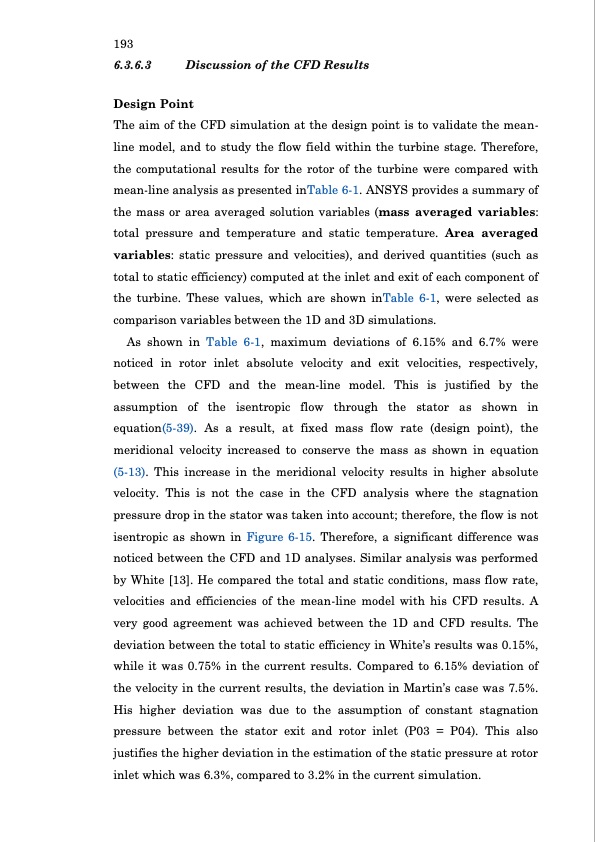
PDF Publication Title:
Text from PDF Page: 212
193 6.3.6.3 Discussion of the CFD Results Design Point The aim of the CFD simulation at the design point is to validate the mean- line model, and to study the flow field within the turbine stage. Therefore, the computational results for the rotor of the turbine were compared with mean-line analysis as presented inTable 6-1. ANSYS provides a summary of the mass or area averaged solution variables (mass averaged variables: total pressure and temperature and static temperature. Area averaged variables: static pressure and velocities), and derived quantities (such as total to static efficiency) computed at the inlet and exit of each component of the turbine. These values, which are shown inTable 6-1, were selected as comparison variables between the 1D and 3D simulations. As shown in Table 6-1, maximum deviations of 6.15% and 6.7% were noticed in rotor inlet absolute velocity and exit velocities, respectively, between the CFD and the mean-line model. This is justified by the assumption of the isentropic flow through the stator as shown in equation(5-39). As a result, at fixed mass flow rate (design point), the meridional velocity increased to conserve the mass as shown in equation (5-13). This increase in the meridional velocity results in higher absolute velocity. This is not the case in the CFD analysis where the stagnation pressure drop in the stator was taken into account; therefore, the flow is not isentropic as shown in Figure 6-15. Therefore, a significant difference was noticed between the CFD and 1D analyses. Similar analysis was performed by White [13]. He compared the total and static conditions, mass flow rate, velocities and efficiencies of the mean-line model with his CFD results. A very good agreement was achieved between the 1D and CFD results. The deviation between the total to static efficiency in White’s results was 0.15%, while it was 0.75% in the current results. Compared to 6.15% deviation of the velocity in the current results, the deviation in Martin’s case was 7.5%. His higher deviation was due to the assumption of constant stagnation pressure between the stator exit and rotor inlet (P03 = P04). This also justifies the higher deviation in the estimation of the static pressure at rotor inlet which was 6.3%, compared to 3.2% in the current simulation.PDF Image | Automotive Radial Turbine Expander Design WHR

PDF Search Title:
Automotive Radial Turbine Expander Design WHROriginal File Name Searched:
automotive-radial-turbine.pdfDIY PDF Search: Google It | Yahoo | Bing
NFT (Non Fungible Token): Buy our tech, design, development or system NFT and become part of our tech NFT network... More Info
IT XR Project Redstone NFT Available for Sale: NFT for high tech turbine design with one part 3D printed counter-rotating energy turbine. Be part of the future with this NFT. Can be bought and sold but only one design NFT exists. Royalties go to the developer (Infinity) to keep enhancing design and applications... More Info
Infinity Turbine IT XR Project Redstone Design: NFT for sale... NFT for high tech turbine design with one part 3D printed counter-rotating energy turbine. Includes all rights to this turbine design, including license for Fluid Handling Block I and II for the turbine assembly and housing. The NFT includes the blueprints (cad/cam), revenue streams, and all future development of the IT XR Project Redstone... More Info
Infinity Turbine ROT Radial Outflow Turbine 24 Design and Worldwide Rights: NFT for sale... NFT for the ROT 24 energy turbine. Be part of the future with this NFT. This design can be bought and sold but only one design NFT exists. You may manufacture the unit, or get the revenues from its sale from Infinity Turbine. Royalties go to the developer (Infinity) to keep enhancing design and applications... More Info
Infinity Supercritical CO2 10 Liter Extractor Design and Worldwide Rights: The Infinity Supercritical 10L CO2 extractor is for botanical oil extraction, which is rich in terpenes and can produce shelf ready full spectrum oil. With over 5 years of development, this industry leader mature extractor machine has been sold since 2015 and is part of many profitable businesses. The process can also be used for electrowinning, e-waste recycling, and lithium battery recycling, gold mining electronic wastes, precious metals. CO2 can also be used in a reverse fuel cell with nafion to make a gas-to-liquids fuel, such as methanol, ethanol and butanol or ethylene. Supercritical CO2 has also been used for treating nafion to make it more effective catalyst. This NFT is for the purchase of worldwide rights which includes the design. More Info
NFT (Non Fungible Token): Buy our tech, design, development or system NFT and become part of our tech NFT network... More Info
Infinity Turbine Products: Special for this month, any plans are $10,000 for complete Cad/Cam blueprints. License is for one build. Try before you buy a production license. May pay by Bitcoin or other Crypto. Products Page... More Info
| CONTACT TEL: 608-238-6001 Email: greg@infinityturbine.com | RSS | AMP |